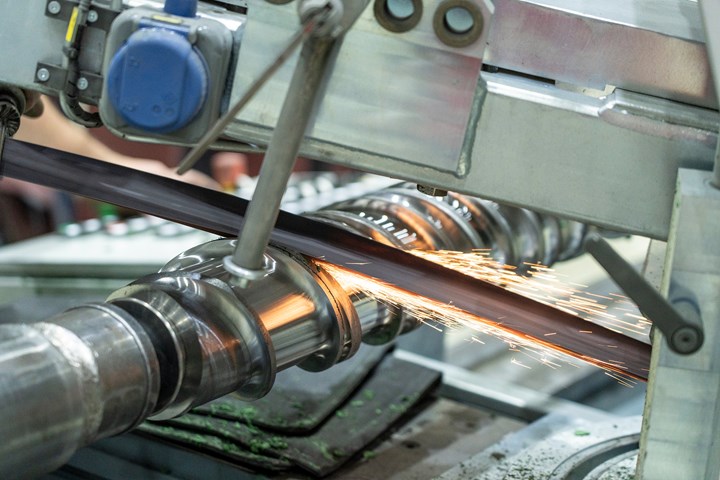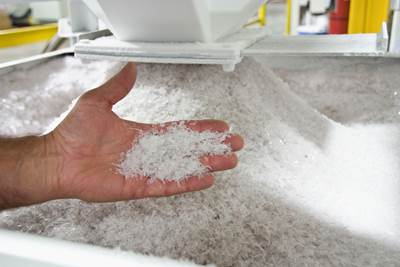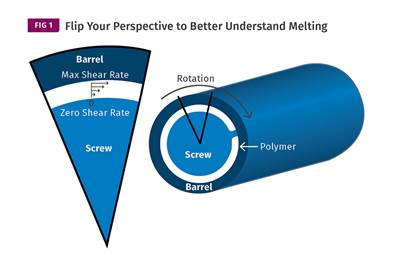Why Are There No 'Universal' Screws for All Polymers?
There’s a simple answer: Because all plastics are not the same.

Differences in the processing characteristics of two such commonly used resins as HIPS and HDPE show why it is difficult to build a screw that works equally well with both. (Photo: Starlinger)
Someone recently asked me about “universal” extrusion screws: “What’s the hold-up? Why can’t there be one screw design to run all polymers?” To many people “plastics” are all the same. But, in fact, different plastic types can have very different processing properties.
A single screw preforms three basic functions: solids conveying, melting and metering or pumping. Each of these functions is controlled by the individual properties of the specific polymer, namely their thermal, viscoelastic, solid and melt density, and frictional properties. These properties can be so diverse that it’s highly unlikely that a universal screw would be able to process them all efficiently. That’s not to say that some polymers cannot be processed at all on a particular screw, but not at their optimum efficiency.
For example, let’s compare HDPE with HIPS—two of the more commonly used polymers in extrusion—by looking at their specific heats and processing temperatures, which is the amount of energy (hp) required to bring them to their processing temperature. In this case the processing temperatures of HDPE and HIPS are relatively similar. But HDPE has an average specific heat of 0.55 Btu/lb-°F, while HIPS has an average specific heat of 0.40 Btu/lb-°F. That means it will take 37.5% more hp to raise the temperature of a pound of HDPE to its processing temperature compared with HIPS.
Polymer properties can be so diverse that it’s highly unlikely that a universal screw would be able to process them all efficiently.
Moreover, HDPE is a crystalline material, meaning it has a defined melting point, while PS is amorphous with no precise melting point. Overcoming HDPE’s crystallinity requires an additional 100 Btu/lb (heat of fusion). So cumulatively, HDPE requires almost 50% more power to reach its processing temperature.
Polymers are also defined by their viscoelastic properties, or how the viscosity changes with changing temperature and shear rate. This is a critical property as it determines how much the shear introduced by the rotation of the screw increases the energy entering the polymer. The power-law coefficient (n) is a measure primarily related to the viscosity as affected by shear rate, and the consistency index (m) is a measure related to the viscosity as affected by temperature. These two properties define the changes in melt viscosity with increasing shear rate and temperature. HIPS has about 50% greater change in viscosity with shear than HDPE (see accompanying table).
HDPE has about 90% of the solid density of polystyrene but only 77% of the melt density. Basically, HDPE breaks down its ordered structure of crystallinity and expands as the melting occurs. This results in a decrease in output (pounds) through the screw; to get equal output/revolution, the screw channels would have to be 38% deeper for HDPE than HIPS. It also requires compensation in the screw compression rate and volume to accommodate the expansion.
As noted above, HIPS has a greater viscosity response to shear rate (power-law coefficient) than HDPE. Therefore, the deeper channels for HDPE to match the lb/hr output of HIPS would result in poor or incomplete melting of HIPS if it were run in the same screw, due to the greater reduction in viscosity and the consequently lower shear melting of the residual HIPS solids.
The feeding rate, which governs the total output of the screw, varies with the physical properties of the feed material such as the particle shape, density, bulk density, internal (particle-to-particle) friction and external friction of polymer particles to the metal surfaces of the extruder hopper, feed throat and barrel. Studies have shown PS has a 50% greater dynamic coefficient of friction against steel than does HDPE. This affects its feed rate as well as the degree of compaction of solids in the early screw channels and ultimately its efficiency of melting.
Dealing with these differences in polymer properties in the screw design is further complicated by the fact that one difference can offset another. For example, HDPE and PS are certainly not wildly different in the respective properties they provide, yet it’s easy to see why it would be difficult to design one screw that can handle both polymers effectively. Now imagine having to design a screw that can also accommodate higher-melting-point polymers such as PC (see table) or polymers that are typically dried before processing.
In these cases, there are some vast differences in properties to deal with. Each property variation can affect the important requirements for efficient and cost-effective processing. The table shows the same properties for PC just to indicate how very different the values are. Consequently, I think we will continue to need specific screw designs for specific polymers.
It’s important to point out that once a good design is developed for a particular polymer using all this polymer property data, it does not have to be done afresh for each size of the new screw design. Scale-up/down ratios are used to develop other sizes with good results. Except for very large changes in size that is usually sufficient to produce the necessary performance.
ABOUT THE AUTHOR: Jim Frankland is a mechanical engineer who has been involved in all types of extrusion processing for more than 50 years. He is now president of Frankland Plastics Consulting LLC. Contact jim.frankland@comcast.net or (724) 651-9196.
Related Content
Improving Twin-Screw Compounding of Reinforced Polyolefins
Compounders face a number of processing challenges when incorporating a high loading of low-bulk-density mineral filler into polyolefins. Here are some possible solutions.
Read MoreUnderstanding Melting in Single-Screw Extruders
You can better visualize the melting process by “flipping” the observation point so the barrel appears to be turning clockwise around a stationary screw.
Read MoreInjection Molding: Focus on these Seven Areas to Set a Preventive Maintenance Schedule
Performing fundamental maintenance inspections frequently assures press longevity and process stability. Here’s a checklist to help you stay on top of seven key systems.
Read MoreThe Effects of Time on Polymers
Last month we briefly discussed the influence of temperature on the mechanical properties of polymers and reviewed some of the structural considerations that govern these effects.
Read MoreRead Next
General-Purpose Screws on the Comeback?
They are being specified more often for recycling applications to increase flexibility. But there is still no such thing as a GP screw and recyclers need to consider other processing approaches.
Read MoreUnderstanding Melting in Single-Screw Extruders
You can better visualize the melting process by “flipping” the observation point so the barrel appears to be turning clockwise around a stationary screw.
Read More
.jpg;width=70;height=70;mode=crop)












